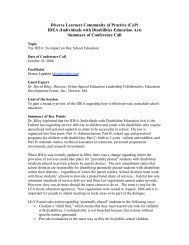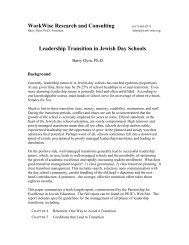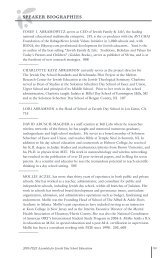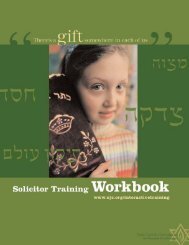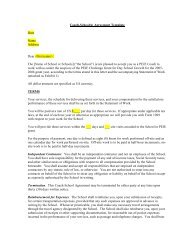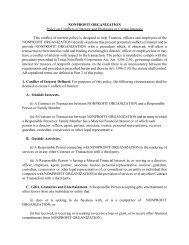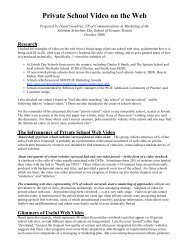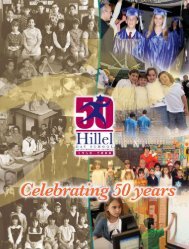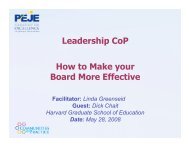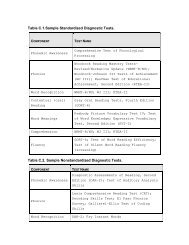âA Lifetim e of Learningâ - Partnership for Excellence in Jewish ...
âA Lifetim e of Learningâ - Partnership for Excellence in Jewish ...
âA Lifetim e of Learningâ - Partnership for Excellence in Jewish ...
Create successful ePaper yourself
Turn your PDF publications into a flip-book with our unique Google optimized e-Paper software.
The best, <strong>in</strong>deed the only, defence <strong>of</strong> a religious people isnot military or political but educational.leadership passed from k<strong>in</strong>gs, priests, andprophets to the sage, the teacher who“raised up many disciples.” Exiled, dispersed,and deprived <strong>of</strong> power, a shatterednation was rebuilt through one <strong>in</strong>strumentality:education.Surviv<strong>in</strong>g DestructionIn the first century C.E. a second crisisstruck with devastat<strong>in</strong>g <strong>for</strong>ce. An ill-advisedrebellion aga<strong>in</strong>st Rome brought savageretaliation. The Roman <strong>for</strong>ces led byVespasian descended on the centres <strong>of</strong> <strong>Jewish</strong>resistance. In 70 C.E. Vespasian’s sonTitus brought the campaign to its climaxwith a siege aga<strong>in</strong>st Jerusalem. The citywas captured. The second Temple was destroyed.It was a fateful moment, thoughfew <strong>of</strong> those who lived through it couldhave known how long Jews would suffer itsconsequences. It was the beg<strong>in</strong>n<strong>in</strong>g <strong>of</strong> thelongest exile Israel has ever known. Notuntil the twentieth century would Jewsaga<strong>in</strong> experience what it was like to be asovereign people <strong>in</strong> their own land.The catastrophe, driven home sixty-fiveyears later with the suppression <strong>of</strong> the BarKochba rebellion, was almost total. Thebasis <strong>of</strong> <strong>Jewish</strong> life lay <strong>in</strong> ru<strong>in</strong>s. The Temple,symbol and centre <strong>of</strong> the nation, wasgone. There were to be no more k<strong>in</strong>gs orprophets, serv<strong>in</strong>g priests or sacrificeswith<strong>in</strong> the <strong>for</strong>eseeable future. The loss <strong>of</strong>the first Temple had been accompanied byhope. There were prophets who <strong>for</strong>etold returnand reconstruction. Now there were nosuch visions, at least none that carried immediatepromise. The loss <strong>of</strong> the secondTemple brought the danger <strong>of</strong> hopelessness.<strong>Jewish</strong> tradition has rightly identified onemoment as a symbol <strong>of</strong> the turn<strong>in</strong>g po<strong>in</strong>t.The Talmud tells <strong>of</strong> how the sage Johananben Zakkai stood out aga<strong>in</strong>st the Jews <strong>of</strong>his day. Dur<strong>in</strong>g the siege <strong>of</strong> Jerusalem,leaders with<strong>in</strong> the city believed that theycould prevail aga<strong>in</strong>st Rome. Johanan knewthey were mistaken and argued unsuccessfully<strong>for</strong> peace. Others believed that theywould be saved by Div<strong>in</strong>e <strong>in</strong>tervention. TheMessiah was about to come. Aga<strong>in</strong>st themJohanan taught, “If you have a sapl<strong>in</strong>g <strong>in</strong>your hand, and people say to you, ‘Behold,there is the Messiah’ - go on with yourplant<strong>in</strong>g and only then go out and receivehim.” Johanan was a religious realist <strong>in</strong> anage <strong>of</strong> dangerous military and apocalypticdreams.Johanan, accord<strong>in</strong>g to the Talmud, had himselfsmuggled out <strong>of</strong> Jerusalem and wastaken to Vespasian. He told the generalthat he would shortly achieve greatness (<strong>in</strong>69 C.E., Vespasian was made Emperor <strong>of</strong>Rome) and made one request. “I ask noth<strong>in</strong>g<strong>of</strong> you except Yavneh, where I might goand teach my disciples and there establisha house <strong>of</strong> study and per<strong>for</strong>m all the commandments.”Johanan predicated <strong>Jewish</strong>survival not on military victory or the messianicage but on a house <strong>of</strong> study and agroup <strong>of</strong> teachers: Yavneh and its sages.Few decisions have had more last<strong>in</strong>g effects.For seventeen hundred years Jewsbecame a people held together by a s<strong>in</strong>glethread: study <strong>of</strong> Judaism’s holy texts. Inplace <strong>of</strong> the temple came the synagogue,the yeshiva, and the bet midrash. In place<strong>of</strong> sacrifices came prayer, learn<strong>in</strong>g, and theper<strong>for</strong>mance <strong>of</strong> good deeds. The mantle <strong>of</strong>We are <strong>in</strong> an unusually good position totest Johanan ben Zakkai’s strategy becausehis was not the only version <strong>of</strong> <strong>Jewish</strong> life.We know from Josephus and other sourcesthat there were several tendencies <strong>in</strong> <strong>Jewish</strong>life <strong>in</strong> the Second Commonwealth. Johananrepresented the group known as thePharisees, who gave rise to the rabbis <strong>of</strong>the Mishnah and Talmud. There was a secondand more powerful group known as theSadducees, who were <strong>in</strong> general wealthierand more closely associated with the Templeand priesthood. Josephus calls the thirdgroup the Essenes. They lived quasimonasticlives <strong>in</strong> small separatist communities<strong>of</strong> which the Qumran sect, known tous through the Dead Sea Scrolls, may havebeen one.For the Sadducees, the central dimension<strong>of</strong> <strong>Jewish</strong> life was the state and its <strong>in</strong>stitutions:the Sanhedr<strong>in</strong> and the Temple. Forthe Essenes it was the messianic age, <strong>for</strong> itappears that they lived <strong>in</strong> imm<strong>in</strong>ent expectation<strong>of</strong> an apocalypse which would shakethe foundations <strong>of</strong> the world. For the Pharisees,as we have seen, it was education.Their key <strong>in</strong>stitution was the school. Theirfigure <strong>of</strong> authority was the scholar. Theirtouchstone <strong>of</strong> <strong>Jewish</strong> identity was <strong>in</strong>dividuallearn<strong>in</strong>g and observance <strong>of</strong> the Torah.Neither Sadducees nor Essenes survived. Of their memory,only the most fragmentary traces rema<strong>in</strong>. There was atime when both groups flourished and when each was conv<strong>in</strong>cedit held the key to the <strong>Jewish</strong> future. But historyruled otherwise. Once aga<strong>in</strong>, education proved the onlyroute to cont<strong>in</strong>uity.P A G E 14 • C O N T I N U I T Y M A G A Z I N E



